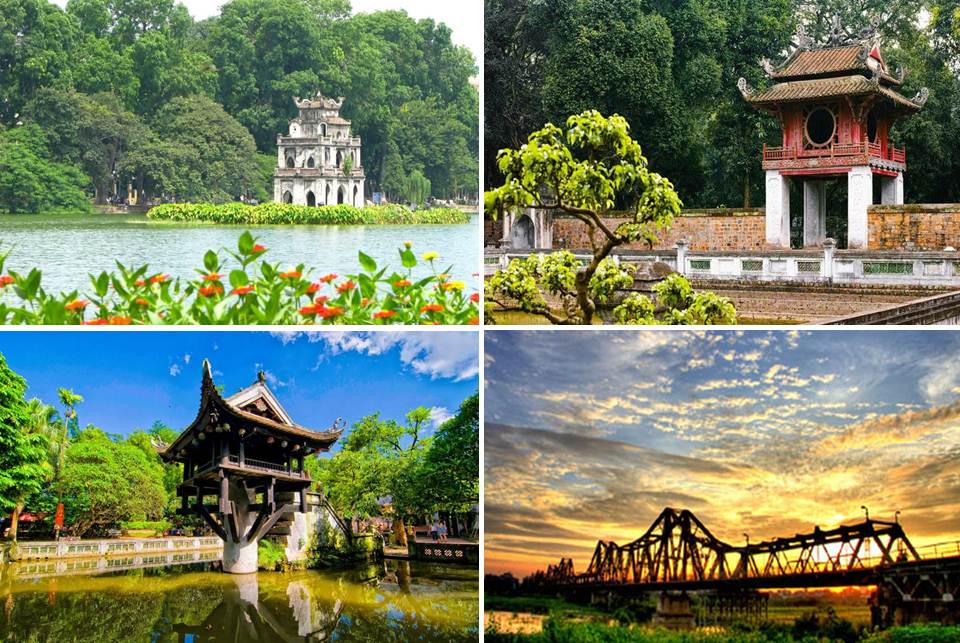As the capital city of Vietnam Hanoi is the second largest city in Vietnam, with over eight million residents within the city proper and an estimated population of 20 million within the metropolitan area. The capital is a commercial, cultural, and educational center of Northern Vietnam. Having an estimated nominal GDP of US$32.8 billion as of 2018, it is the second most productive economic area of Vietnam, after Ho Chi Minh City.
Climate
Hanoi features a warm humid subtropical climate with plentiful precipitation. The city experiences the typical climate of northern Vietnam, with four distinct seasons.
Lasting from February to April, Hanoi’s spring is humid and wet with drizzles. The average temperature normally ranges from 15 to 20 degree. Summer, from May to August, is characterized by hot and humid weather with abundant rainfall. Fall is quite short, typically from middle of September to the end of November, with an average temperature of around 25 degree. The cold weather of Hanoi will start from December and may last until late February, with the average temperature of 17 degree. However, sometimes it may drop to below 10 degree, so bringing some serious warm clothes is necessary to not get a cold.
Transport
Hanoi is served by Noi Bai International Airport, approximately 15 km north of Hanoi. To go to the city center, there are some airport route buses with the fare of 30,000 – 40,000 VND ($1,4 – $2 /one-way).
The main means of transport within Hanoi city are motorbikes, buses, taxis, and a rising number of cars. For students in Hanoi, the most usual transports are motorbike and bus.
The traffic laws in Vietnam requires a driver license to ride a motorbike of more than 50cc. Wearing helmet is always compulsory when using motorbike. Public buses are also available with very cheap fares: around 7,000-9,000 VND/one-way.
Longer distance travel can be done by long-distance bus, train, or by air if people want to visit other regions of the country.
Food
Hanoi has rich culinary traditions. Many of Vietnam’s most famous dishes, such as phở, bún chả, chả cá Lã Vọng, bánh cuốn and cốm are believed to have originated in Hanoi. Perhaps most widely known is Phở—a simple rice noodle soup often eaten as breakfast at home or at street-side cafes, but also served in restaurants as a meal.
Health
If you want to find out a hospital, the private ones is good choice for foreign tourists and foreign people living in Hanoi as they accept international health insurance with international standard services and facilities. Some options around HUST’s campus:
- Hanoi French Hospital: https://www.hfh.com.vn/en/
Tel: 0243 3577 1100
Add: No.1 Phuong Mai Street, Dong Da District, Hanoi
- Hanoi Medical University Hospital: http://benhviendaihocyhanoi.com/?language=en
Tel: 024.3574 7979 – 0982873112
Add: No.1 Ton That Tung Street, Dong Da District, Hanoi
- Vinmec International Hospital: https://www.vinmec.com/en/
Tel: 0243 9743 556
Add: 458 Minh Khai, Hai Ba Trung, Hanoi
Besides, HUST has a Medical and Health care services inside the campus that provides medical examination and treatment services for all local and international students. Students having health problems or any medical concerns can make appointments to see the doctors.
Sport
In Hanoi, there are a lot of gyms and fitness clubs which are popping up. It is around $30-200 per month for gym membership or $10-22 USD per day for Boxing or Muay Thai class. Some options for you:
- Golden Gym Club (Gym for Students) https://goldengym.vn/en/home/
- California Fitness & Yoga Center https://fit.cfyc.com.vn/
Accommodation
HUST students are eligible for accommodation in the university campus. The university dormitories can accommodate more than 4000 students. If you want to find more comforatble accommodation, the External Affairs Office can assist you to find several ones close to the campus under the kind of homestay.
Located in the area where gathered a number of universities in Hanoi, it is not hard for students to find an accommodation close to HUST’s campus will reasonable price and fully furnished.
Banking and finance
There is a number of international banks operating in Vietnam such as HSBC, Shinhan and Standard Chartered. However, it is highly recommended for international students to register a local bank account when living in Vietnam such as Vietcombank, Techcombank, BIDV or VietinBank. All of those have their branches around HUST, so students can withdraw foreign or local currency easily. Making payments using VISA/Mastercard debit or credit cards is also common at supermarkets, restaurants, and hotels…, but cash remains the most common form of payment for local basic deals such as street market.
Living cost
In general, the living cost in Hanoi is a bit higher than most places in Vietnam. The estimated living cost for a foreign student is around from $400-500 USD per month for basic needs as food, house renting, transportation…
Landmarks






 Tiếng Việt
Tiếng Việt